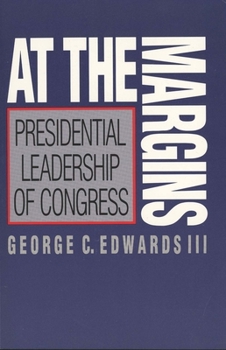At the Margins: Presidential Leadership of Congress
Select Format
Select Condition 
Book Overview
In this book George Edwards seeks a deeper understanding of the relationship between the president and Congress, exploring how and under what conditions presidents lead Congress, what we can reasonably expect of them, and how we should evaluate their performance. He makes a persuasive case for his thesis that presidential leadership of Congress is typically at the margins, not the core, of policymaking. Edwards focuses on three important resources for presidential leadership: party, public opinion, and legislative skills. For each source of influence he analyzes the president's strategic position, the theoretical potential of the resource as an instrument of leadership. He then examines presidents' attempts to employ each resource to obtain support in Congress, showing that they are rarely able to expand their resource base or manipulate their resources reliably. Integrating quantitative analysis with documentary and historical research, Edwards argues that the effective leader is not the dominant chief executive of political folklore who restructures the contours of the political landscape to pave the way for change but is rather a facilitator who works at the margins of coalition building to exploit opportunities presented by a favorable configuration of political forces in his environment. Presidents are not by themselves going to bring about major changes in public policy, says Edwards, and we must adjust accordingly our expectations of their leadership. The implications of his book are broad, and his findings are an important corrective for those who personalize politics and attribute more influence to a single person or strategy than is usually merited.
Format:Paperback
Language:English
ISBN:0300048998
ISBN13:9780300048995
Release Date:July 1990
Publisher:Yale University Press
Length:247 Pages
Weight:0.85 lbs.
Dimensions:0.8" x 6.1" x 9.2"
Customer Reviews
1 rating
Limitations of Presidential Leadership
Published by Thriftbooks.com User , 16 years ago
Edwards examines the ways a president attempts to "lead" congress, that is, how a president persuades Congress to support presidential initiatives. Edwards contends that there are three sources of presidential influence; (1) the president's position as party leader, (2) the president's approval in the eyes of the public, and (3) the president's personal legislative skills. However, we must keep in mind that the influence garnered from these sources is not tremendously powerful, or capable of commanding legislative subservience. Rather, the influence has marginal effects, but these small, marginal effects can, at times, and given the right circumstances, gain support for presidential initiatives. The first variable influencing presidential influence is the strategic position of the president as party leader. Party members in congress may have a personal or emotional loyalty to the party, and subsequently the party's leader, the president. Furthermore, party members may have incentives to make the president look good as it improves the approval of the party. Party members may also distrust the opposition, or they may have similar policy preferences as the president. As such, party members may be receptive to presidential influence. However, party support for the president is not guaranteed. First, partisan support for the president slips over time. Members may begin to disagree with the president on particulars. Second, party members may have constituent interests that are different from the president (Kingdon 1992, Jones 1994). Third, party members may defect if presidential policy diverges too much from the traditional party platform. Fourth, there are different factions within the party. Here we could think of "Blue Dog" Democrats. Fifth, party members may not want to associate with an unpopular president. Nevertheless, the president has some sources of power which allow him to influence party members "at the margins." These include making personal appeals to party members, working with congressional leadership, and selective incentives (both positive and negative). First, the president may make personal appeals to partisan congressmen to garner support. Still, the president must be conscious that this must be rare in order for such a technique to remain effective. This illustrates the fact that the president doesn't have the power to give orders. He must rely on the "soft sell" (73). Second, the president can appeal to floor and committee leaders. These actors could have significant sway with the party rank-and-filed. However, the president has to work hard to court the support of the party leaders. The separation of powers grants them a good deal of autonomy. Additionally, due to the decentralization of parties, power has become much more dispersed and the leadership may not have the sway it once did. In this environment, the president has limited incentives at his disposal to shape/pursue support of party members.





